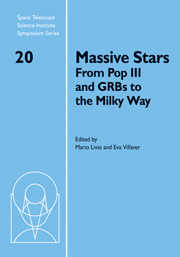Book contents
- Frontmatter
- Contents
- Participants
- Preface
- High-mass star formation by gravitational collapse of massive cores
- Observations of massive-star formation
- Massive-star formation in the Galactic center
- An x-ray tour of massive-star-forming regions with Chandra
- Massive stars: Feedback effects in the local universe
- The initial mass function in clusters
- Massive stars and star clusters in the Antennae galaxies
- On the binarity of Eta Carinae
- Parameters and winds of hot massive stars
- Unraveling the Galaxy to find the first stars
- Optically observable zero-age main-sequence O stars
- Metallicity-dependent Wolf-Rayet winds
- Eruptive mass loss in very massive stars and Population III stars
- From progenitor to afterlife
- Pair-production supernovae: Theory and observation
- Cosmic infrared background and Population III: An overview
Massive stars: Feedback effects in the local universe
Published online by Cambridge University Press: 04 August 2010
- Frontmatter
- Contents
- Participants
- Preface
- High-mass star formation by gravitational collapse of massive cores
- Observations of massive-star formation
- Massive-star formation in the Galactic center
- An x-ray tour of massive-star-forming regions with Chandra
- Massive stars: Feedback effects in the local universe
- The initial mass function in clusters
- Massive stars and star clusters in the Antennae galaxies
- On the binarity of Eta Carinae
- Parameters and winds of hot massive stars
- Unraveling the Galaxy to find the first stars
- Optically observable zero-age main-sequence O stars
- Metallicity-dependent Wolf-Rayet winds
- Eruptive mass loss in very massive stars and Population III stars
- From progenitor to afterlife
- Pair-production supernovae: Theory and observation
- Cosmic infrared background and Population III: An overview
Summary
Massive stars as a population are the source of various feedback effects that critically impact the evolution of their host galaxies. We examine parameterizations of the high-mass stellar population and self-consistent parameterizations of the resulting feedback effects, including mechanical feedback, radiative feedback, and chemical feedback, as we understand them in the local universe. To date, it appears that the massive-star population follows a simple power-law clustering law that extends down to individual field massive stars, and the robust stellar IMF appears to have a constant upper-mass limit. These properties result in specific patterns in the H II-region luminosity function, and the ionization of the diffuse, warm, ionized medium. The resulting supernovae generate a population of superbubbles whose distributions in size and expansion velocity are also described by simple power laws, and from which a galaxy's porosity parameter is easily derived. A critical star-formation threshold can then be estimated, above which the escape of Lyman-continuum photons, hot gas, and nucleosynthetic products is predicted. A first comparison with a large sample of Hα observations of galaxies is broadly consistent with this prediction, and suggests that ionizing photons are likely to escape from starburst galaxies. The superbubble size distribution also offers a basis for a Simple Inhomogeneous Model for galactic chemical evolution, which is especially applicable to metal-poor systems and instantaneous metallicity distributions. This model offers an alternative interpretation of the Galactic halo metallicity distribution and emphasizes the relative importance of star-formation intensity, in addition to age, in a system's evolution. The fraction of zero-metallicity, Population III stars is easily predicted for any such model. We emphasize that all these phenomena can be modeled in a simple, analytic framework over an extreme range in scale, offering powerful tools for understanding the role of massive stars in the cosmos.
- Type
- Chapter
- Information
- Massive StarsFrom Pop III and GRBs to the Milky Way, pp. 74 - 92Publisher: Cambridge University PressPrint publication year: 2009
- 2
- Cited by



